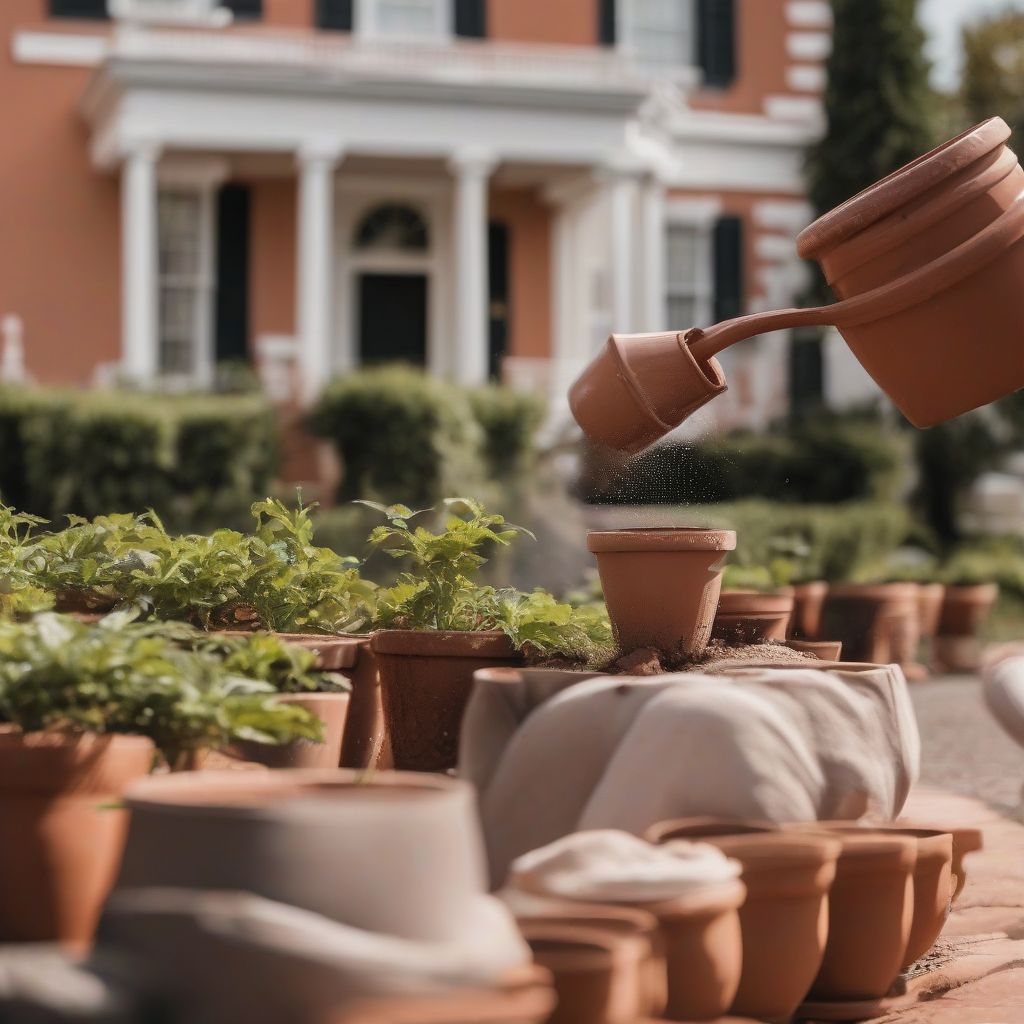Have you ever gazed upon a lush window box overflowing with vibrant blooms and wondered, “What’s their secret?” While sunlight and water are essential, the magic often lies in proper fertilization. Container gardening, you see, presents a unique set of challenges. Unlike their in-ground counterparts, potted plants rely on you, their dedicated caretaker, to provide the nutrients they need to flourish. But don’t worry, mastering the art of container fertilization is easier than you think! This comprehensive guide will empower you with the knowledge to nourish your potted plants for optimal growth and dazzling displays.
Understanding the Needs of Container Plants
Before we dive into the “how-to,” let’s take a moment to understand why fertilization is crucial for container plants:
- Limited Soil Volume: The restricted root space in containers means a finite supply of nutrients. Regular watering further depletes these vital resources.
- Nutrient Depletion: Every leafy green, vibrant bloom, and juicy tomato your plant produces draws upon the soil’s nutrient reserves.
- Environmental Factors: Exposure to wind, sun, and rain can impact nutrient availability and even leach them from the soil.
By providing a consistent supply of essential nutrients through fertilization, you empower your plants to thrive in their container homes.
Choosing the Right Fertilizer
Selecting the right fertilizer can feel overwhelming, but fear not! Here’s a breakdown to guide your decision:
Types of Fertilizer
- Granular Fertilizers: These slow-release granules provide a steady nutrient supply over several weeks or months. They are ideal for established plants and those requiring less frequent feeding.
- Liquid Fertilizers: Fast-acting and easy to apply, liquid fertilizers offer a quick nutrient boost. They are perfect for seedlings, actively growing plants, and addressing specific deficiencies.
- Slow-Release Fertilizers: These ingenious options, available in spikes, pellets, or capsules, release nutrients gradually over an extended period, minimizing the risk of over-fertilization.
NPK Ratio: The Magic Formula
Fertilizers display an NPK ratio, representing the percentage of Nitrogen (N), Phosphorus (P), and Potassium (K) they contain. Each nutrient plays a vital role:
- Nitrogen (N): Fuels leafy green growth.
- Phosphorus (P): Promotes root development, flowering, and fruiting.
- Potassium (K): Enhances overall plant health, disease resistance, and fruit quality.
Choosing the right NPK ratio depends on your plants:
- Leafy Greens: Opt for a higher nitrogen fertilizer, such as a 10-5-5 ratio.
- Flowering Plants: Choose a balanced fertilizer or one with a higher phosphorus content, like 10-20-10.
- Vegetables and Fruits: A balanced fertilizer or one slightly higher in potassium, such as 5-5-10, will support healthy yields.
Organic vs. Synthetic Fertilizers
- Organic Fertilizers: Derived from natural sources like compost, manure, or bone meal, they release nutrients slowly, improving soil structure and promoting beneficial microbial activity.
- Synthetic Fertilizers: These manufactured fertilizers provide a quick and concentrated nutrient dose. While effective, use them cautiously to prevent over-fertilization.
Ultimately, the best fertilizer for your container garden depends on your plant’s specific needs, your preferences, and the fertilizer’s availability.
When and How to Fertilize
Timing is everything! Here’s a general guideline for fertilizing container plants:
- Growing Season: Fertilize regularly during the active growing season (spring and summer) when plants are using the most nutrients.
- Dormancy: Reduce or stop fertilization during fall and winter when plants enter dormancy.
- Frequency: The frequency depends on the type of fertilizer and your plants’ needs. Granular fertilizers may last for several months, while liquid fertilizers are applied every 2-4 weeks.
- Watering: Always water your plants thoroughly after fertilizing to distribute nutrients evenly and prevent root burn.
Tips for Fertilizing Success
- Less is More: Start with half the recommended fertilizer dose to avoid over-fertilizing. You can gradually increase the amount as needed.
- Observe Your Plants: Yellowing leaves, stunted growth, or poor flowering can indicate nutrient deficiencies. Adjust your fertilization schedule accordingly.
- Flush Excess Salts: Over time, fertilizer salts can build up in container soil, harming your plants. Flush the containers every few months by running water through them for several minutes.
- Repotting: Refresh the potting mix every 1-2 years to replenish nutrients and provide fresh soil for your plants to thrive.
 Fertilizing Plants in Pots
Fertilizing Plants in Pots
Common Container Fertilizing Mistakes (and How to Avoid Them)
Even the most experienced gardeners can fall prey to these common fertilization pitfalls:
- Over-Fertilizing: More fertilizer is not always better! Over-fertilizing can lead to root burn, leaf scorch, and even plant death. Follow the recommended dosage on the fertilizer label and err on the side of caution.
- Under-Fertilizing: While over-fertilizing poses a threat, under-fertilizing can stunt your plants’ growth and prevent them from reaching their full potential. Establish a regular fertilization schedule and stick to it.
- Ignoring Soil Testing: Soil testing provides valuable insights into your potting mix’s nutrient levels, allowing you to tailor your fertilization strategy for optimal plant health.
- Fertilizing Stressed Plants: If your plants are already stressed due to overwatering, underwatering, or pests, fertilizing can exacerbate the problem. Address the underlying issue before providing additional nutrients.
Expert Tips for Thriving Container Gardens
To elevate your container gardening game, we consulted with renowned horticulturalist, Dr. Jane Greenthumb, author of “The Container Gardener’s Bible”:
“Container gardening is all about creating a microcosm of ideal growing conditions,” says Dr. Greenthumb. “By providing the right balance of water, sunlight, and nutrients, you empower your plants to thrive, even in limited spaces.”
She emphasizes the importance of choosing the right fertilizer for your plants’ specific needs and adjusting the fertilization schedule based on their growth stage and the time of year.
Conclusion
Mastering the art of container fertilization empowers you to cultivate a thriving oasis of greenery, even in the smallest of spaces. By understanding the unique needs of container plants, choosing the right fertilizer, and following a consistent fertilization schedule, you can unlock your plants’ full potential and enjoy an abundance of vibrant blooms, lush foliage, and bountiful harvests. Remember, a little care goes a long way in the world of container gardening!
Now that you’re armed with the knowledge to fertilize your container plants like a pro, it’s time to put your newfound skills into action! Share your container gardening triumphs with us in the comments below. Happy growing!
[amazon bestseller=”container gardening”]
